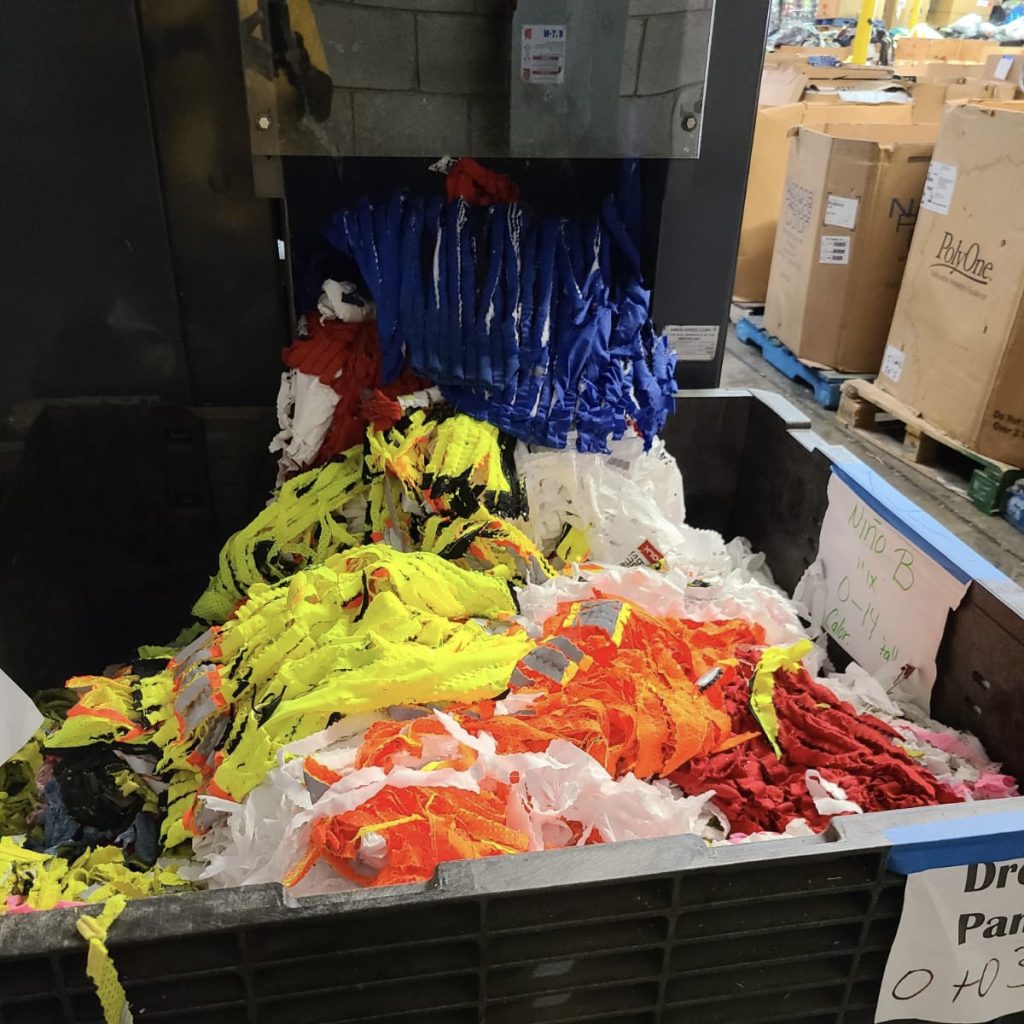Textile Recycling Services in Raleigh, North Carolina
Contact us today at 817-946-5655
We offer many clothing and textile recycling services in Raleigh, North Carolina. We are the only clothing and textile-recycling company in Raleigh, North Carolina that can provide a closed loop textile recycling program. Our clothing recycling programs in Raleigh, North Carolina are the best in the world. If you need textile recycling in Raleigh, North Carolina please call us to set up a program. The 6 main services we offer are listed below as well as information on the textile recycling industry.
Clothing Manufacture Take Back Programs
Brands and clothing makers that join the ClothingTakeBack.com recycling platform have an immediate consumer recycling program that provides environmentally friendly closed loop recycling for their customers across the country.
Each company that joins ClothingTakeBack.com has access to our recycling data including the weight collected, weight of material processed, expected yarn production, and environmental benefits from recycling. Brands can access their recycling efforts 24/7 to track where they are in achieving recycling goals. Brands provide the collection of old clothes through a mail-back program with ClothingTakeBack.com or an in store drop off. The brands on ClothingTakeBack.com will have clothing recycled into fibers. These fibers are then turned into new recycled cotton yarn. The yarn is then made available for the brands to use in new clothing.
Retail Store Collection Bins
Retail store clothing collection bins are an easy and convenient way to provide recycling options for customers. We have multiple styles and types of collection bins that can fit in any space.
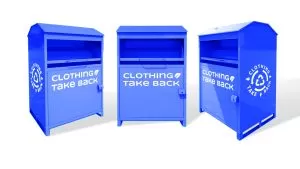
Uniform Destruction
Large corporations with thousands of employees generate an overwhelming amount of textile waste from old uniforms. We help solve this problem. Many large corporations such as The World of Coca-Cola, Microsoft, Google, and Tesla are working with us to reduce their carbon footprint through recycling old employee uniforms.
Product Destruction
Clothing and Textile Shredding
Companies that have textiles or clothing that do not meet specifications or can’t be sold can have an instant textile and clothing shredding service. We shred clothing and textiles to help protect brands from defective products, counterfeit goods, discontinued items, or other items that just need to be destroyed. After shredding the materials we use the fiber in other products such as stuffing for furniture, insulation, or carpet padding.
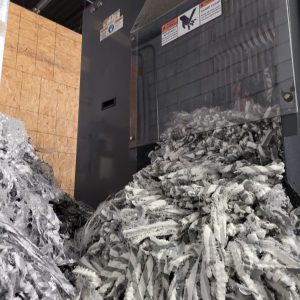
Used Clothing Resale
Most donated clothing is sold as second hand apparel. A lot of this material moves through charitable organizations or exporters who sell the clothing to developing countries. If you have used clothing in bulk that you want sale we have a service for you.
Out Door Clothing Collection Bins
If you want to have an out door clothing collection bin on your location we can help. Many local authorities regulate out door collection bins. We can help you navigate this process to start collecting clothing.
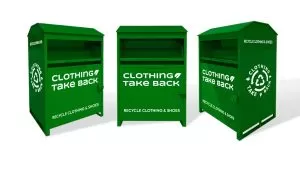
If you need any of the above services please contact us at 817-946-5655 or email at [email protected].
Textile Waste Problem
Textile Recycling is important because there is so much textile waste. The EPA (Environmental Protection Agency) estimates that textile waste makes up 6 percent of all the material going into the landfill. That equals an estimated 26 million pounds of textile waste per year being thrown away. However, nearly 95 percent of textile waste can be reused or recycled.
What are Textiles?
Textiles can be a wide range of products made from fibers. The textiles that most people are familiar with are clothing, footwear, towels, bedding, linens, and other fabric based products. Some other textiles are belts, hats, curtains, and draperies.
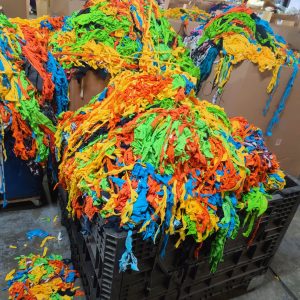
Clothing Made in the United States
Clothing is the second largest consumer sector in the economy. People buy 20 billion pieces of clothing each year, which is equal to 68 garments each year per person. However, Made in the USA clothing has declined since 1970. During 1970, 75 percent of clothing was made in the USA but has declined to 2 percent as of 2013.
Raleigh Textile Recycling and the Environment
Textile recycling is one of the most beneficial forms of recycling due to the large benefits in reducing greenhouse gases. Recycling 2.3 million tons of clothing per year is equal to removing 1.3 million cars from the road. Cotton is the main material used in producing textiles and clothing. However, cotton needs more pesticides than any other crop in the world. It can take up to a third of a pound of pesticide to produce on t-shirt. Synthetic materials can be even more harmful to the environment than natural materials. Most synthetic materials are made from petroleum-based fibers such as polyester and nylon and can produce large amounts of volatile organic compounds, nitrous oxide, and create lots of polluted water.
Raleigh Textile Recycling and Clothing Reuse
Many non-profit companies accept textiles and used clothing for reuse. Most donations get resold to second hand stores or get sold to exporters who sell them to developing countries. Because clothing collected in North America is typically high quality, it sells well in countries such as Africa, Latin America, and other developing countries. Some estimates show that parts of Africa wear 95 percent used clothing.
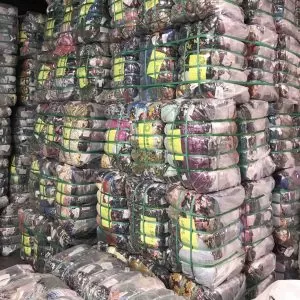
Recycling Textiles into Rags
The average person throws away 70 pounds of textiles per year. A lot of this material can be cut up into rags for commercial operations. Places like car washes, machine shops, marinas, and auto shops need rags on a regular basis. The rag business has been around for hundreds of years and is a good way to give new life to old textiles.
Recycling Textiles into Fiber
Clothing and textiles that can not be reused or cut into rags can be processed into fibers. When the clothing is processed into fibers it can be used as stuffing for furniture, insulation, or carpet padding.
Clothing Collection Bins
Clothing collection bins are usually placed around the city in public places. However, unless you know where they are, they can be hard to find. Clothing collection bins are typically a receptacle or container made of metal, steel, or wood and is designed for the donation and temporary storage of clothing. Typically cities have regulations on placing a clothing collection bin in public. Make sure you check with local authorities before you place one in public.
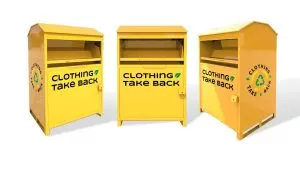
Natural Textile Fibers
Natural fibers can be classified by cellulose and protein based fibers. Two of the most widely used and most popular cellulose based fibers are hemp and cotton. Some of the most widely know protein based fibers are alpaca, camel, cashmere, mohair, wool and silk.
Man Made Textile Fibers
Synthetic fibers are popular in the textile industry because they can be made and can sometimes be cheaper. Some widely used synthetic fibers are acrylic, nylon, polyester, and spandex. These fibers all have different properties and are used in different textile applications. Some natural polymer man made fibers are rayon and lyocell.
Organic Cotton versus Non-Organic Cotton
Cotton farming is a major worldwide industry. Some experts estimates there are 100 million farmers in the world growing cotton in more than 80 countries. Organic cotton has many benefits to non-organic cotton. Organic cotton farmers are free to save seeds and replant the seeds to grow new crops. When farmers rotate crops the soil is nurtured and makes it sustainable over time. Most organic cotton is grown along side with food which helps the soil and produces food to eat. Another benefit of organic cotton is that hazardous and poisonous pesticides are banned from being used to grow organic cotton. By growing organic cotton farmers use less energy which creates less greenhouse gases.
Non-organic cotton seeds are mostly controlled by Monsanto which locks farmers into contracts for their seeds. Pesticides are a major problem for non-organic cotton farmers. Non-organic cotton farming uses 16 percent of the worlds insecticides and 10 percent of the worlds pesticides resulting in 77 million poisonings a year. The environment suffers extremely as 83 percent of manufactured fertilizers end up in the environment and water supply. Because of the high use of water in non-organic farming a large number of CO2 is released into the air.
Cotton versus Hemp
Hemp has some benefits when compared to cotton. However, we don’t feel that hemp can replace cotton. Hemp can produce 2 times the amount of fiber per acre. Hemp only uses 2 liters of water compared to 9 liters for cotton. Hemp can be grown 14 years on the same soil without needing to be rotated with other crops. Hemp also requires no pesticides. Hemp fiber is 4 times more durable than cotton. Hemp has some special qualities and can be a good resource in textile manufacturing.
